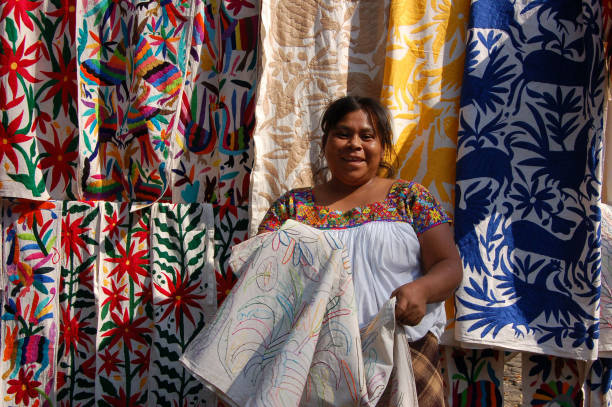Exploring the Diverse Textile Traditions of Mexico's Indigenous Peoples
Mexico is home to a number of indigenous groups, each with their own unique textile traditions. These traditions are an important part of the indigenous peoples' cultural identity and a testament to their skill and creativity.
One group that is known for their beautiful textiles is the Huichol, who live in the Sierra Madre Occidental range in the states of Nayarit, Jalisco, Zacatecas, and Durango. They are known for their intricate beadwork and other forms of art, which are deeply connected to their spiritual beliefs and traditions. The Huichol use beadwork to decorate everyday objects such as bowls, plates, and even vehicles.
Another group with a rich textile tradition is the Maya, who live in the Yucatán Peninsula. They are known for their vibrant and colorful textiles, which are an important part of their cultural identity. Maya textiles are made using traditional techniques such as backstrap loom weaving, and are often brightly colored and feature bold patterns and geometric designs.
The Tarahumara, who live in the Sierra Madre mountains in the states of Chihuahua and Durango, are also known for their traditional weaving techniques. They use a variety of natural fibers, including wool, cotton, and agave, to create beautiful textiles and objects.
Other groups with notable textile traditions include the Mixteca in the central highlands, the Otomí in the central plateau, the Tzotzil in the Chiapas highlands, the Zapotec in the Oaxaca Valley, and the Purépecha in the west. These groups are known for their embroidery, weaving, and other textile techniques, and their textiles are often brightly colored and feature intricate patterns and designs.
Overall, the indigenous peoples of Mexico have a diverse range of textile traditions, including beadwork, embroidery, and weaving. These traditions are an important part of their cultural identity and a testament to their skill and creativity. They are an important part of the region's economy and a rich cultural tradition that should be celebrated and supported.
How Are They Made?
Here is a step-by-step guide to how some of the indigenous peoples of Mexico make their textiles:
- Gather materials: The first step in making textiles is to gather the materials that will be used. This might include natural fibers such as wool, cotton, or agave, as well as dyes and other supplies.
- Prepare the fibers: Once the materials have been gathered, the fibers will need to be prepared for weaving or other textile techniques. This might involve spinning the fibers into yarn, or preparing them in some other way.
- Set up the loom: Depending on the technique being used, the next step might involve setting up a loom. For example, in backstrap loom weaving, the loom is attached to a stationary object at one end and to the weaver's waist at the other end. In vertical loom weaving, a larger, stationary loom is used.
- Weave the textile: Once the loom is set up, the actual process of weaving the textile can begin. This involves interlacing the fibers to create the desired pattern and design.
- Embroider the textile: In some cases, the textile might be embroidered once it has been woven. This involves using a needle and thread to add decorative patterns and designs to the surface of the textile.
- Finish the textile: Once the textile is complete, it will need to be finished. This might involve washing and drying the textile, or applying any additional decorative elements such as beads or fringe.
Overall, the process of making textiles is a time-honored tradition that requires skill, patience, and attention to detail.
What potential usage can these textiles be used as?
There are many ways that you can use textiles made by the indigenous peoples of Mexico. Some possible ways to use these textiles include:
- Wear them as clothing: Many indigenous textiles are made into clothing, such as dresses, skirts, skirts, and other garments. Wearing these textiles is a great way to celebrate and honor the culture of the indigenous peoples who made them.
- Use them as home decor: Textiles can also be used to decorate your home. You can hang them on walls as tapestries, drape them over furniture, or use them as throw pillows or blankets.
- Display them as artwork: Textiles can also be displayed as artwork in their own right. You can frame them and hang them on walls, or you can display them on easels or other types of stands.
- Use them as gifts: Textiles make great gifts, especially if they have a cultural or personal significance. You can give them as presents to friends and family, or you can use them as part of a gift basket or other gift set.
Overall, there are many ways to use textiles made by the indigenous peoples of Mexico. Whether you use them as clothing, home decor, artwork, or gifts, these textiles are a beautiful and meaningful way to celebrate and honor the culture of these communities.
I hope that this tour through the diverse textile traditions of the indigenous peoples of Mexico has been educational and inspiring for you.
These traditions are a testament to the skill and creativity of these communities, and they are an important part of their cultural identity.
Whether you use these textiles as clothing, home decor, artwork, or gifts, they are a beautiful and meaningful way to celebrate and honor the culture of these communities.
I encourage you to support these traditions by purchasing authentic, handmade textiles made by indigenous artisans rather than mass-produced imitations. This helps to preserve these traditions and provide income for the communities that depend on them.
Thank you for joining me on this tour of the textile traditions of Mexico's indigenous peoples. I hope that you will continue to learn about and appreciate the rich cultural heritage of these communities.













Comments
Post a Comment